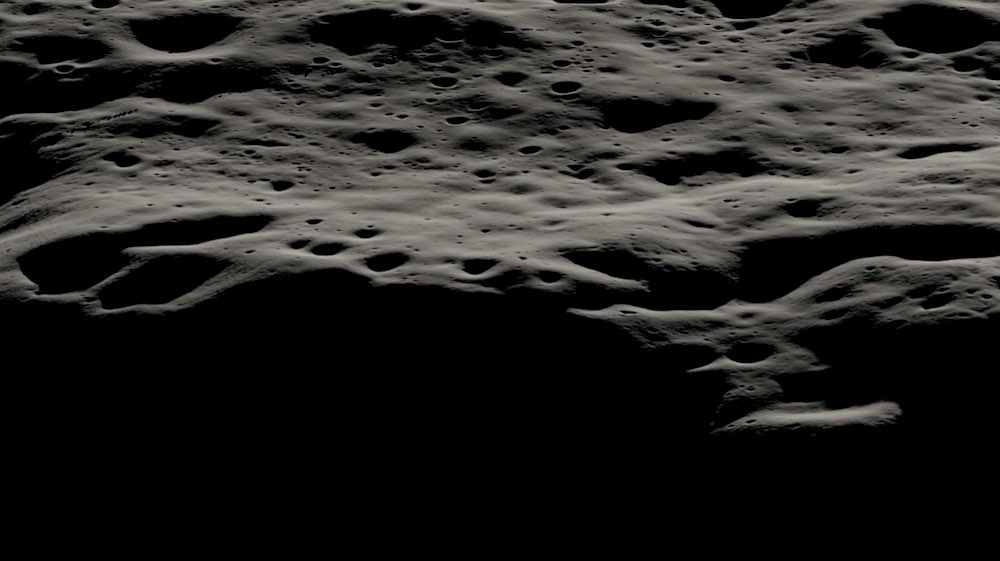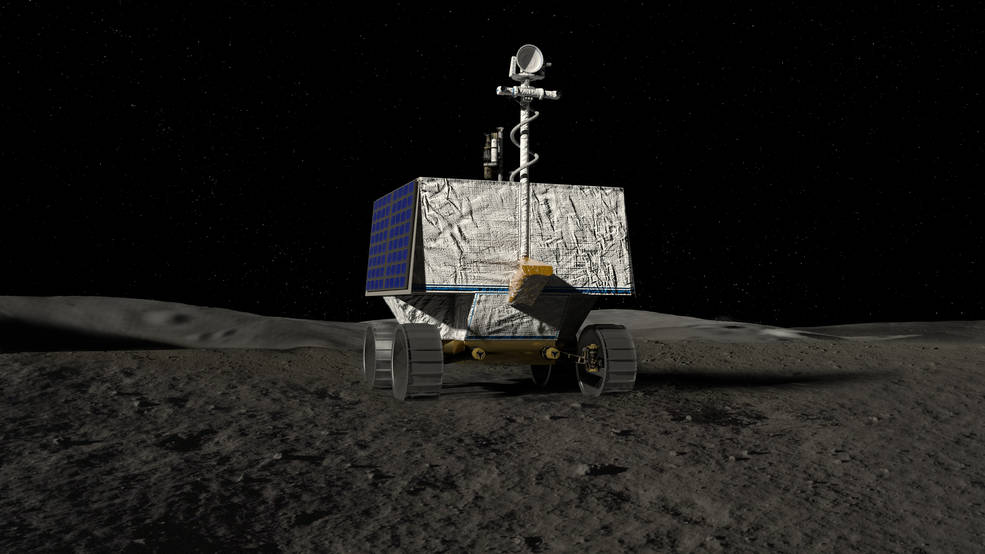|
Listen to this article  |
In 2023, NASA’s Volatiles Investigating Polar Exploration Rover (VIPER) will land near the western edge of the Nobile Crater at the Moon’s South Pole to map and explore the region’s surface and subsurface for water and other resources. Part of Artemis, VIPER will launch on a SpaceX Falcon-Heavy rocket for delivery to the Moon by Astrobotic’s Griffin lander under NASA’s Commercial Lunar Payload Services initiative.
The Moon’s South Pole is one of the coldest areas in the solar system. No prior missions to the Moon’s surface have explored it – scientists have thus far only studied the region using remote sensing instruments, including those on NASA’s Lunar Reconnaissance Orbiter and the Lunar Crater Observation and Sensing Satellite.
Data from these and other missions helped scientists conclude that ice and other potential resources exist in permanently shadowed areas of the Moon near the poles. After an extensive landing site selection process, the mountainous area west of Nobile Crater was chosen as VIPER’s landing site due to its rover-accessible terrain and array of nearby sites of scientific interest, including permanently shadowed areas.
“Once on the lunar surface, VIPER will provide ground truth measurements for the presence of water and other resources at the Moon’s South Pole, and the areas surrounding Nobile Crater showed the most promise in this scientific pursuit,” said Thomas Zurbuchen, associate administrator for science at NASA Headquarters. “The data VIPER returns will provide lunar scientists around the world with further insight into our Moon’s cosmic origin, evolution, and history, and it will also help inform future Artemis missions to the Moon and beyond by enabling us to better understand the lunar environment in these previously unexplored areas hundreds of thousands of miles away.”
Nobile Crater is an impact crater that was formed through a collision with another smaller celestial body, and is almost permanently covered in shadows, allowing ice to exist there. Smaller, more accessible craters surrounding Nobile’s perimeter, will also provide VIPER with ideal locations to investigate in its search for ice and other resources.
“Selecting a landing site for VIPER is an exciting and important decision for all of us,” Daniel Andrews, VIPER project manager, said. “Years of study have gone into evaluating the polar region VIPER will explore. VIPER is going into uncharted territory—informed by science—to test hypotheses and reveal critical information for future human space exploration.”

A visualization showing the area west of Nobile Crater and the smaller craters that litter its rim at the lunar South Pole. The Nobile region is most suitable for VIPER to navigate, communicate, and characterize potential water and other resources. | Credit: NASA
Landing site selection
NASA’s team evaluated viable rover traverse paths, taking into account where VIPER could use its solar panels to charge and stay warm during its 100-day journey. The area near Nobile Crater provided a lot of flexibility.
VIPER’s currently planned trajectory allows the rover to visit at least six sites of scientific interest, with additional time to spare.
“Our evaluation of the landing site was driven by science priorities,” said Anthony Colaprete, VIPER lead project scientist at NASA’s Ames Research Center in Silicon Valley, California. “We seek answers to some pretty complex questions and studying these resources on the Moon that have stood the test of time will help us answer them.”
The VIPER team aims to address how frozen water and other resources arrived on the Moon in the first place. They also plan to identify where they came from, how they remained preserved for billions of years, how they escape, and where they go.
VIPER’s journey across Nobile
The area VIPER will study in the Nobile region covers an approximate surface area of 36 square miles (93 square kilometers), 10 to 15 miles (16 to 24 km) of which VIPER is expected to traverse through during the course of its mission. During this time, the rover will visit carefully chosen areas of scientific interest that will provide further insight into a wide array of different kinds of lunar environments. The VIPER team will look to characterize ice and other resources in these areas using VIPER’s sensors and drill.
As VIPER moves among each area of scientific interest, it will collect samples from at least three drill locations. Analysis of these samples from a variety of depths and temperatures will help scientists to better predict where else ice may be present on the Moon based on similar terrain, allowing NASA to produce a global resource map. This map, and the other science VIPER will produce, will allow scientists to better understand the distribution of resources on the Moon and help inform future crewed missions to establish a long-term presence on the lunar surface.

NASA’s Volatiles Investigating Polar Exploration Rover (VIPER) is a mobile robot that will go to the South Pole of the Moon to get a close-up view of the location and concentration of water ice that could eventually be harvested to sustain human exploration on the Moon, Mars — and beyond. | Credit: NASA
VIPER’s design
Measuring 8 feet tall and 5 feet in length and width, this mid-sized rover can traverse inclines of as much as 15 degrees. The rover’s four wheel modules are designed with both an active suspension and independent steering. This means VIPER can drive sideways or diagonally and even spin in a circle. VIPER can move in any direction without changing the way it’s facing, so its science objectives and solar-panel charging can be optimized.
Generally, VIPER will drive at about 0.5 MPH over the lunar surface, slowing to 0.25 MPH when prospecting for water and other potential resources. VIPER’s camera system will allow operators on Earth to visualize the terrain the rover needs to navigate and send commands in near-real time based on what they see – where and how fast to move, and where to stop and search for water ice. Typically, the operators will tell the rover to move between 12 and 25 feet (4 to 8 meters), before downlinking data and reassessing.
The onboard computer is the brain of the rover that will help VIPER do its job and includes software for running commands sent from Earth, processing data from VIPER’s sensors, operating its instruments and driving. Since the Moon is much closer to Earth than Mars, there will be little delay when communicating with VIPER, allowing some of the rover’s functions to be performed here on Earth, such as creating maps of the rover’s environment to track its position and mapping the resources it finds.
VIPER will carry four instruments, including the Regolith and Ice Drill for Exploring New Terrains (TRIDENT) hammer drill, the Mass Spectrometer Observing Lunar Operations (MSolo) instrument, the Near Infrared Volatiles Spectrometer System (NIRVSS) and the Neutron Spectrometer System (NSS). Earlier versions of these instruments will be tested on the lunar surface ahead of the VIPER mission, allowing the team to reduce risk and test instrument performance data.
Editor’s Note: This article was republished from NASA.
Credit: Source link


Comments are closed.